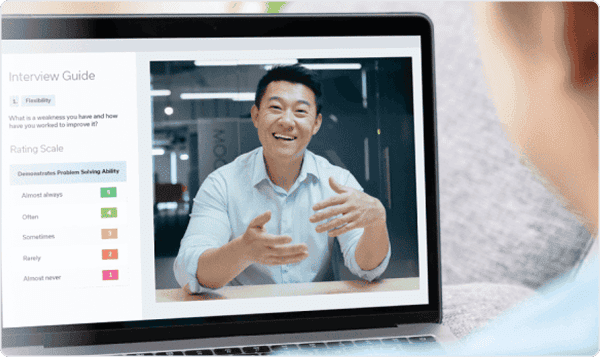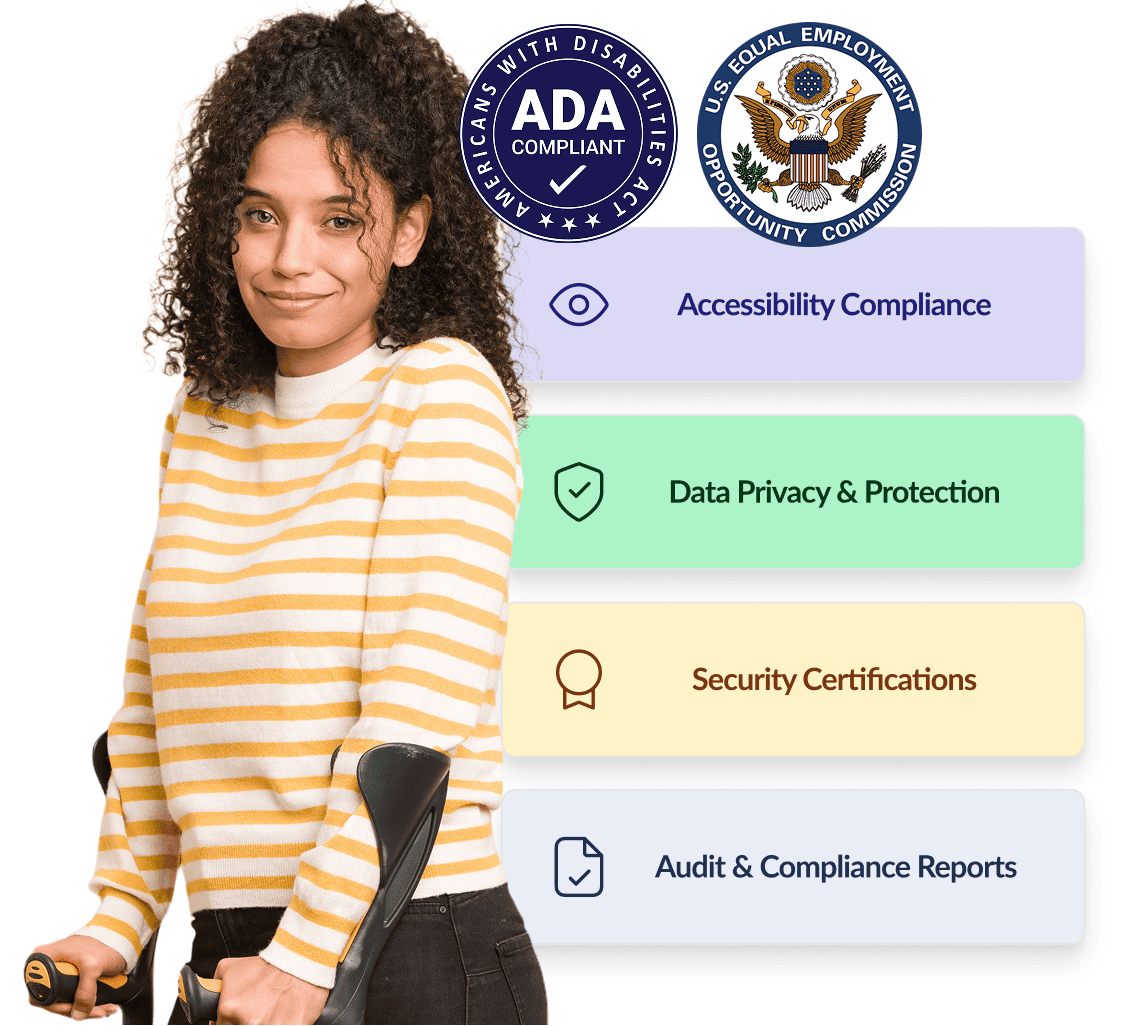
How to Create a Structured Interview Process
Learn how structured interviewing can streamline your evaluation process, reduce bias, and help you find the best candidates for your open positions.
Written by
VidCruiter Editorial TeamReviewed by
VidCruiter Editorial TeamLast Modified
Nov 5, 2025
TL;DR
An estimated 386 million working-age people around the world have some form of disability, according to the International Labor Organization. Coupled with the World Economic Forum reporting that most professionals will work up to a dozen jobs over their lifetime, this means nearly every employer will, at some point, receive applications from candidates with diverse abilities and accessibility needs.
Every applicant deserves an equal opportunity to be considered and to move through the hiring process without facing barriers or the impact of bias. And digital interviewing has undoubtedly made that easier in many ways, by allowing candidates to record responses on their own time and participate remotely. Yet without proper design and oversight, these same technologies can also create new accessibility challenges, from software that doesn’t support assistive tools to automated systems that unintentionally screen out qualified candidates.
To stay compliant and create a fair experience, HR leaders and hiring teams need to understand two key frameworks: the Americans with Disabilities Act (ADA), and the Equal Employment Opportunity Commission (EEOC). This article explores what ADA and EEOC compliance in digital interviewing looks like, and why it matters when evaluating accessible recruitment tools.

Accessibility and anti-discrimination laws both apply to digital interviewing. In particular, the Americans with Disabilities Act (ADA) and the Equal Employment Opportunity Commission (EEOC) regulations guide how employers approach this process. Understanding both is key to building fair and compliant interview practices.

The Americans with Disabilities Act is a civil rights law that protects people with disabilities from being discriminated against, both in employment and daily life. For employers, this means making sure every part of the hiring process, including applications, interviews, and assessments, is easily accessible for people with a wide range of disabilities.
Zooming in on digital interviews, every video platform, interview scheduling portal, or assessment tool used as part of the hiring environment should be accessible. If a candidate can’t fully participate because the software lacks captioning or doesn’t offer assistive technology, it may violate the ADA’s “effective communication” standard.
Employers also have an ongoing duty to provide reasonable accommodations when requested, making sure every digital interview attendee has a fair opportunity to demonstrate their qualifications. Examples include:
The EEOC enforces federal laws that protect applicants and employees from discrimination based on their:
These laws apply to every stage of employment, including how interviews are designed, delivered, and evaluated. In practice, this means HR teams should:
Following these steps demonstrates good-faith interview compliance with both EEOC and ADA expectations while protecting the organization from legal and reputational risk.
Globally, people with disabilities have an estimated employment rate of 44%, compared to 75% for those without disabilities. It’s a significant gap that illustrates just how difficult it is for people with disabilities to move smoothly through the hiring process and obtain the job they applied for.
Many highly qualified candidates encounter barriers along the way, including difficulties throughout the digital interview process.
Even supposedly inclusive digital interviewing processes can inadvertently exclude qualified applicants when the experience isn’t designed with accessibility in mind. While every candidate’s situation is different, the following issues can appear across online hiring tools:

When a digital interview process fails to meet accessibility or equal opportunity standards, the consequences can include:
When interviews move online, the responsibility for ADA compliance extends to both the software employers choose and how interviews are administered. Here’s what to consider as you create a compliant digital interview process.
Platform Accessibility
Accessible video interviewing starts long before candidates log in. Here’s what employers should insist on when researching hiring software vendors for ADA and EEOC compliance.
Clear Communication and Candidate Support
Even the most accessible platform can fall short if communication isn’t clear. Candidates should know what to expect and how to request any available accommodations. Some best practices include:
Testing for Accessibility
Accessibility is an ongoing process that should be built into every software rollout or update by:
Enabling candidates to access the interview is only half the equation. The next step is making sure the process itself doesn’t unintentionally favor some applicants over others, which is where EEOC compliance comes in.
Avoiding Discriminatory Bias
Under EEOC guidance, digital interviewing systems are treated as part of an employer’s selection procedures. This includes any use of automation or AI, such as tools that analyze tone, speech patterns, or facial expressions. These systems fall under Title VII and ADA scrutiny. Employers are responsible for minimizing the impact of bias and ensuring they don’t disproportionately screen out candidates from protected groups. The EEOC’s 2024-2028 Strategic Enforcement Plan makes technology-driven discrimination a national priority, directing investigators to review AI and software used in hiring decisions, including video interviews provided by third-party vendors.
Practical steps:
Data Privacy and Equal Access
Digital interviewing often involves collecting sensitive candidate data, for example, behavioral data based on video interviews. Under EEOC guidance and data-protection principles, employers must handle this information responsibly and check that access to interviews is equal for all applicants.
Key considerations:

Strong compliance must be built into every step of the hiring process. These practices help organizations keep digital interviewing accessible, fair, and fully aligned with ADA and EEOC expectations.
Use clear, bias-free language in job postings and interview invitations, and include a short accessibility statement that explains how candidates can request accommodations. Early transparency sets the tone for a fair and welcoming experience.
Maintain detailed records of interview guides, scoring, accommodation requests, and candidate communications. A complete paper trail shows that every applicant was evaluated consistently and supports compliance if questions arise later.
Train anyone involved in hiring on ADA and EEOC basics, including how to recognize and respond to accommodation requests. Ongoing education helps teams apply structured interviewing practices correctly and maintain a consistent, fair candidate experience.
Review digital interview data regularly to check for potential accessibility issues or patterns of adverse impact. Internal audits help organizations identify small gaps before they become compliance risks and demonstrate a commitment to continuous improvement.
88% of companies use some form of AI during candidate screening, according to the World Economic Forum. But as AI becomes more common, compliance teams must treat these systems like any other selection procedure. The EEOC’s 2024-2028 enforcement plan highlights algorithmic bias as a priority, meaning employers remain responsible for outcomes even when third-party software is involved.
Before using AI-based scoring, confirm that the tool measures job-related skills, doesn’t rely on tone or facial analysis, and has been tested for adverse impact. Always maintain human oversight and provide an alternative process for candidates who have trouble accessing automated systems.
Yes. VidCruiter’s platform is designed to align with both the Americans with Disabilities Act (ADA) and the Equal Employment Opportunity Commission (EEOC) regulations that govern fair and accessible hiring. Here’s how:
Interview experiences in VidCruiter are designed to be accessible for all candidates. The platform supports screen readers, captioning, and flexible navigation options so applicants can complete interviews in the way that works best for them. Employers can also adjust timing and format when accommodations are needed, helping meet ADA expectations for equal access. Accessibility is reviewed regularly to ensure every candidate can move smoothly through the process.
VidCruiter supports employers in following EEOC guidance for digital hiring by keeping the interview process structured and consistent. Standardized question sets and anchored rating guides allow interviewers to evaluate candidates on the same job-related criteria every time.
Interview scorecards, notes, and communications are automatically documented, creating a clear record of how each hiring decision was made. This consistency helps organizations show that their interviews are objective and always aligned with equal employment regulations.
A “disparate effect” happens when a seemingly neutral process ends up excluding certain groups more than others. Built-in structure and transparency within VidCruiter help reduce that risk. Consistent workflows and comparable scoring make it easier to identify potential imbalances early, giving HR teams the information they need to tweak their workflows before any issues arise.
Every part of the interview process leaves a traceable record, from interview guides and scoring data to accommodation notes and messages with candidates. These details are stored securely in one place, creating an easy-to-follow audit trail if a compliance review is ever needed.
Having this information organized supports ADA and EEOC obligations and gives hiring teams the insight to refine and improve their process over time.

Achievement First, a network of charter schools in the U.S., screens around 5,000 applications a year with a small team of 11 recruiters, ultimately hiring 500 people annually. To achieve compliance and consistency across such high-volume hiring cycles, the team has adopted VidCruiter for its pre-recorded video interviews and automated reference checks. Achievement First now benefits from:
Learn how to prioritize EEOC and ADA compliance in your digital interviewing processes by booking a free VidCruiter demo.
A major red flag in virtual interviews is when the technology prevents certain candidates from fully participating. Examples include missing captions, time limits that can’t be adjusted, or platforms that don’t work with assistive technologies like screen readers. These barriers can create accessibility gaps or even legal risks under ADA and EEOC rules.
One of the most common ADA violations in hiring is failing to provide reasonable accommodation. This happens when an employer doesn’t adjust the process to meet a candidate’s accessibility needs, such as offering captions for a video interview or extra time for someone with a processing disability. Other frequent issues include using digital platforms that aren’t compatible with assistive technology or overlooking accessibility in application portals.
To check for ADA compliance in digital hiring tools, start by reviewing whether your software meets recognized accessibility standards like WCAG 2.1 AA. Many organizations request a Voluntary Product Accessibility Template (VPAT) from their technology vendor, which outlines how closely the system aligns with ADA requirements. You can also use free accessibility testing tools and perform manual checks with screen readers or keyboard-only navigation.
Modernize your hiring process with expert insights and advice.